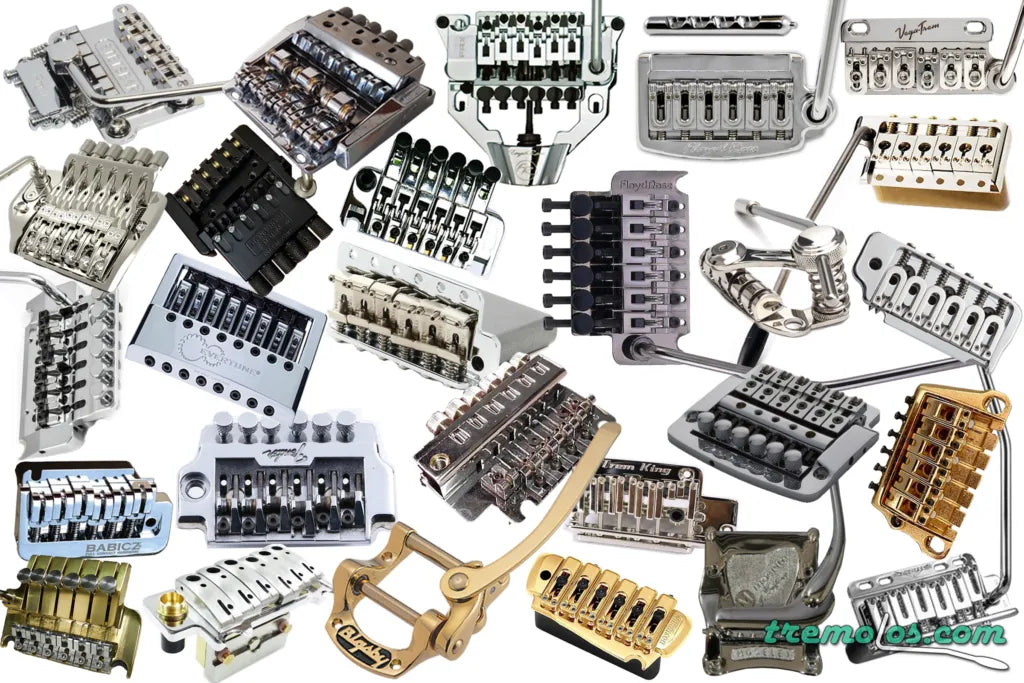
Guide to Tremolo Bridges

What is a Tremolo or Vibrato bridge system?
These are special types of bridges that allow you to lower, and sometimes raise, the pitch of your guitar's strings by temporarily increasing or decreasing tension with an arm operated by your picking hand, typically called a whammy bar, twang bar, or tremolo/vibrato arm. The "tremolo" terminology can be a bit confusing, because more commonly the modulating of pitch is called "vibrato". "Tremolo" usually refers to volume modulation, or to passages of fast repeated notes. Both are correct, and both are used regularly, but since many of the bridges made for guitars are called tremolo systems, we wanted to clarify!
Bigsby

Bigsby vibrato tailpieces are considered the earliest vibrato bridge design ever offered! Using a tailpiece with a spring loaded arm to slack the strings, the first known units came on the scene in 1951, and its believed that the first guitarist given one was the great Merle Travis, best known as the originator of Travis picking.
These systems are regularly seen on Gretsch guitars, among others, and are great for adding a sparkly vibrato to chords and single notes, or a twangy punch to deep low notes. Another upside is that many of the designs can top mount on a guitar that’s already fitted with a tune-o-matic style bridge, eliminating the need to route a cavity for a sustain block and spring claw like many other systems require.
Some potential downsides are that they’re not usually the best option for super heavy use, so if you want to do dive bombs and wild bends, it might be best to check out some other options. Additionally, restringing can be a bit more finicky than other systems, but luckily there are more modern options available that make this more manageable than the originals!
Something to keep in mind is that these tailpieces seem to do best with slightly heavier strings, and in order to change the angle of the tremolo arm, whether for preference or to accommodate new string gauges, you may need to replace the spring with one of another size or rigidity. Stylistically they have a bold look, and really add a style all their own to any guitar they're added to!
6-Screw Synchronized Tremolo

First introduced in 1954 as a standard option on the Fender Stratocaster, it's no exaggeration to say the Synchronized Tremolo changed guitar playing (and tremolo design) forever. Favored by players like Jimi Hendrix, Jeff Beck, Eric Clapton, and even on Eddie Van Halen's earlier guitars, the Synchronized Tremolo allowed for a greatly increased range of motion than earlier behind-the-bridge designs.
Featuring a screw-in arm with 6 individual adjustable bent-steel saddles and 6 pivot screws attached to the top of the guitar's body, this design requires a cavity in the back of the guitar to fit the string block attached to the underside of the bridge. The strings run through the block and over the saddle to the tuner, the block then attaches with springs to an adjustable claw that is screwed in the cavity. Most of these design elements are present in modern tremolo designs, and many are found in todays hardtail bridge designs as well!
These are ideal for players seeking a vintage-correct tone and feel when using the tremolo arm. Tuning stability is reasonable with moderate use if the guitar is setup correctly, and this design tends to work particularly well for those looking to add many springs to slam the bridge down, effectively using it as a hardtail.
2-point Synchronized Tremolo

Likely invented by Floyd Rose in 1976, and used on G&L guitars in the early 80's, this updated take on the Synchronized Tremolo became standard on Fender guitars by 1986. This design does away with the 6-pivot screw layout in favor of two knife edges attached to larger posts on the outside of the bridge, decreasing the surface area at the point of contact, and increasing tuning stability. The bent steel saddles on most offerings are replaced with more robust, machined saddles, leading to less string binding and slippage in the saddle.
There are many versions of this type of design available today, it offers the best of the vintage and modern worlds, and is widely used by many manufacturers as a standard option on their models. It is familiar, easy to adjust, and extremely stable for all but the most extreme use, and a great choice for a wide variety of players!
Double-Locking

Floyd Rose first patented his Double-Locking tremolo in 1979, with single locking designs similar to the Synchronized Tremolo built as early as 1976. The system utilizes a clamping mechanism to lock the string at the nut, and a screw adjusted block to lock the string at the bridge, where it is inserted with no ball-end and tuned using a thumbscrew fine tuner. These systems are rock solid, and allowed for the confident use of tremolo bridges in extreme circumstances. First popularized by Eddie Van Halen on his guitars built by Kramer, these quickly became a wildly popular choice with rock and metal musicians looking to use their bridge to the extreme! Some players prefer a dive-only setup, while others go for a fully recessed cavity, popularized by Steve Vai, allowing for super wide movement in either direction.
With many licensed and variations on the original design, a double-locking Floyd Rose style design is tough to beat for a tremolo fanatic, and those looking to take advantage of their unique feel and techniques that can be hard to replicate with other designs. They can also add a bit of a unique airiness to the tone of a guitar, and a specific slack to the strings that some players love!
Downsides are that they can be a bit overbuilt and overcomplicated for players who don't need the level of stability that they offer. Some players may not like the way they sound and feel compared to more traditional tremolo designs. String changes and setups will typically take a bit longer or cost a bit more, and the larger bridge design and large metal nut can get in the way for some players
Fender Floating Bridge

Introduced on the Jazzmaster in 1958, the Fender Floating Bridge is a unique design, that is mainly found on Jazzmaster or Jazzmaster style guitars. It is a fully contained unit, top mounted in a cavity with a vertical spring inside the cavity that can be adjusted via a screw in the center of the unit.
In addition to having a beautifully smooth action when using the tremolo arm, these bridges leave a lot of string length between the bridge saddles and the vibrato unit, which enables some players to make use of the sympathetic vibrations and behind-the-bridge plucks and bends to create interesting sounds and textures.
There can sometimes be issues with stability at the saddle, especially when using lighter strings, and initial setups can be tricky to dial in, but these bridges offer some unique features and a unique feel, and for those that love them, there is no real substitute. There are some popular replacements for this well loved bridge that seek to work out some of the issues users have with them for those interested!
Kahler Cam Tremolo

While seemingly similar to the Double Locking Floyd Rose, these bridges are quite unique in design, and offer some similar features, and a feel that is irreplaceable for some players. The ball end is cradled in a slot in front of the fine tuners, and the tremolo arm moves a cam to change the angle of the string over the roller saddle to raise and lower pitch. The unit is top mounted and self contained, with hex screws located on the cam to adjust the spring tension, or to fix the bridge like a hardtail. Traditionally, the strings are clamped at the headstock behind the nut, with some updated designs using a locking mechanism instead of a nut, similar to a Floyd Rose.
These offer an incredible smoothness and range when using the tremolo arm, favored by players like Kerry King and Jerry Cantrell for both wild flurries of dives and squeals, and more subtle vibrato and note bends. If a Kahler is something you love, it's hard to do without.
Installation is a bit invasive, the units are heavy, complex, and have many moving parts deterring a lot of players from checking them out. We implore you to give them a shot if you're a heavy tremolo user, or a whammy bar enthusiast looking to try something new!
What made you decide it was time to own a tremolo equipped guitar? Was it the intense dive bombs heard throughout aggressive guitar driven music that caught your ear? The swirly psychedelic tremolo use of Jimi Hendrix? Maybe it’s the swooping, emotive chirps and bends heard when listening to Jeff Beck or even Allan Holdsworth. Perhaps you’re most drawn to the subtle vibrato on chords from players like Chet Atkins, or heard throughout many of the great rockabilly and country recordings. Whatever it is, we're just happy so many different designs exist to enable all sorts of playing and satisfy different creative tastes!
Thank you for reading! Drop a comment below, we'd love to know your favorite tremolo units and players!
